Comprehensive Analysis of Plastic Waste Management in Australia
VerifiedAdded on 2022/08/25
|32
|9507
|20
Report
AI Summary
This report delves into the critical issue of plastic waste management, with a specific focus on the Australian context. It begins by highlighting the global problem of plastic pollution and its environmental consequences, emphasizing the need for effective waste management strategies. The report then provides an overview of the current situation in Australia, including consumption rates, recycling rates, and the challenges associated with plastic waste. It explores various methods of plastic waste management, such as landfill, incineration, and recycling, with a particular emphasis on recycling. The importance of plastic sorting as a crucial step in the recycling process is discussed, along with the different methods used for sorting, including manual and automated techniques. The report also examines the current scenario of waste management in Australia, specifically in Brisbane, including the roles of waste management companies like SUEZ and Toxfree. Methods used for recycling in Brisbane are described, detailing the processes from household collection to sorting and recycling. The report also discusses the issue of landfilling by plastic waste, the need for proper sorting of plastics, and the potential use of recycled plastics in low-grade applications. Furthermore, it touches upon the limitations and challenges associated with plastic recycling, such as contamination and the distortion of polymer structures. The report concludes by summarizing the key findings and emphasizing the importance of sustainable plastic waste management practices for environmental protection.
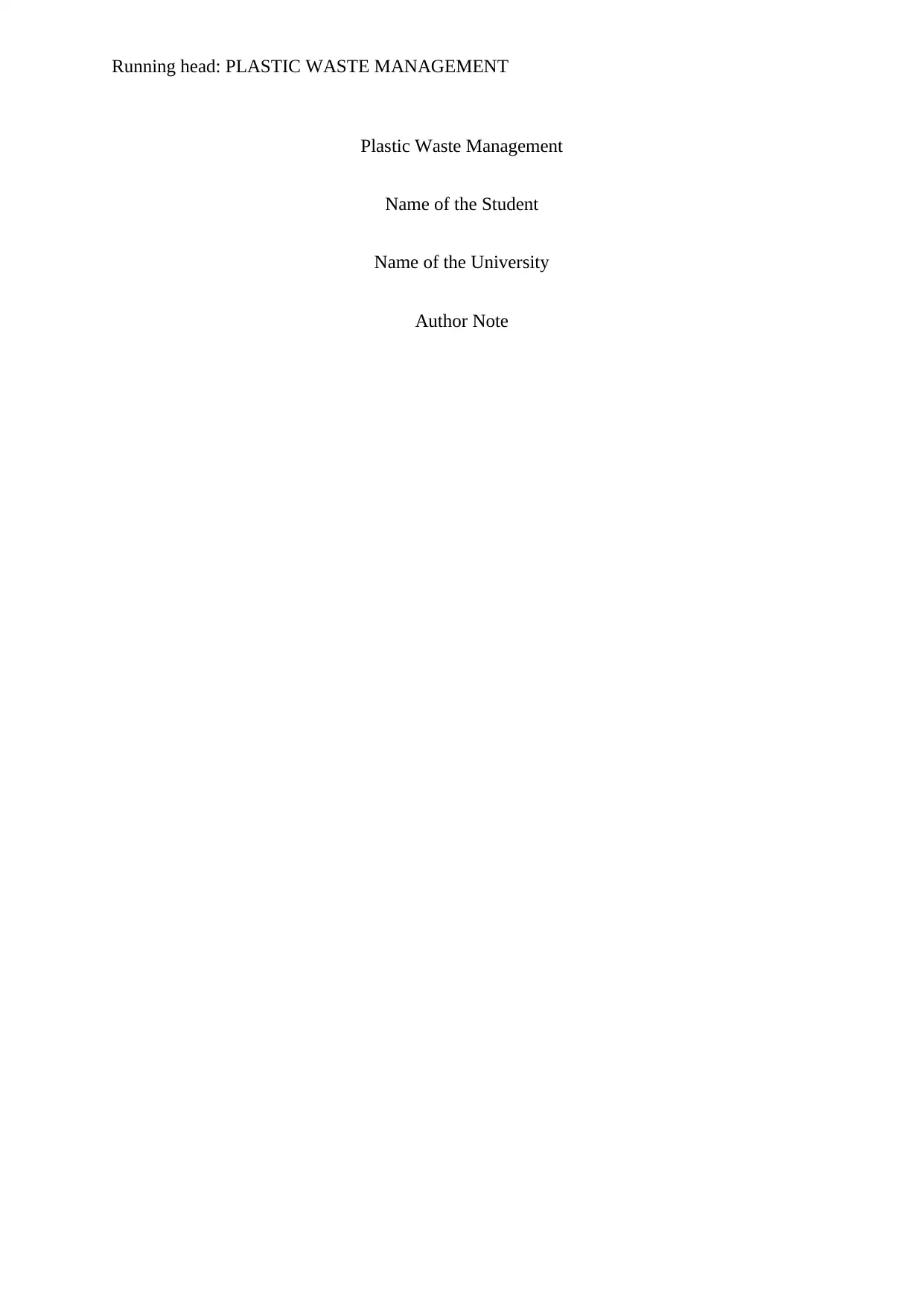
Running head: PLASTIC WASTE MANAGEMENT
Plastic Waste Management
Name of the Student
Name of the University
Author Note
Plastic Waste Management
Name of the Student
Name of the University
Author Note
Paraphrase This Document
Need a fresh take? Get an instant paraphrase of this document with our AI Paraphraser
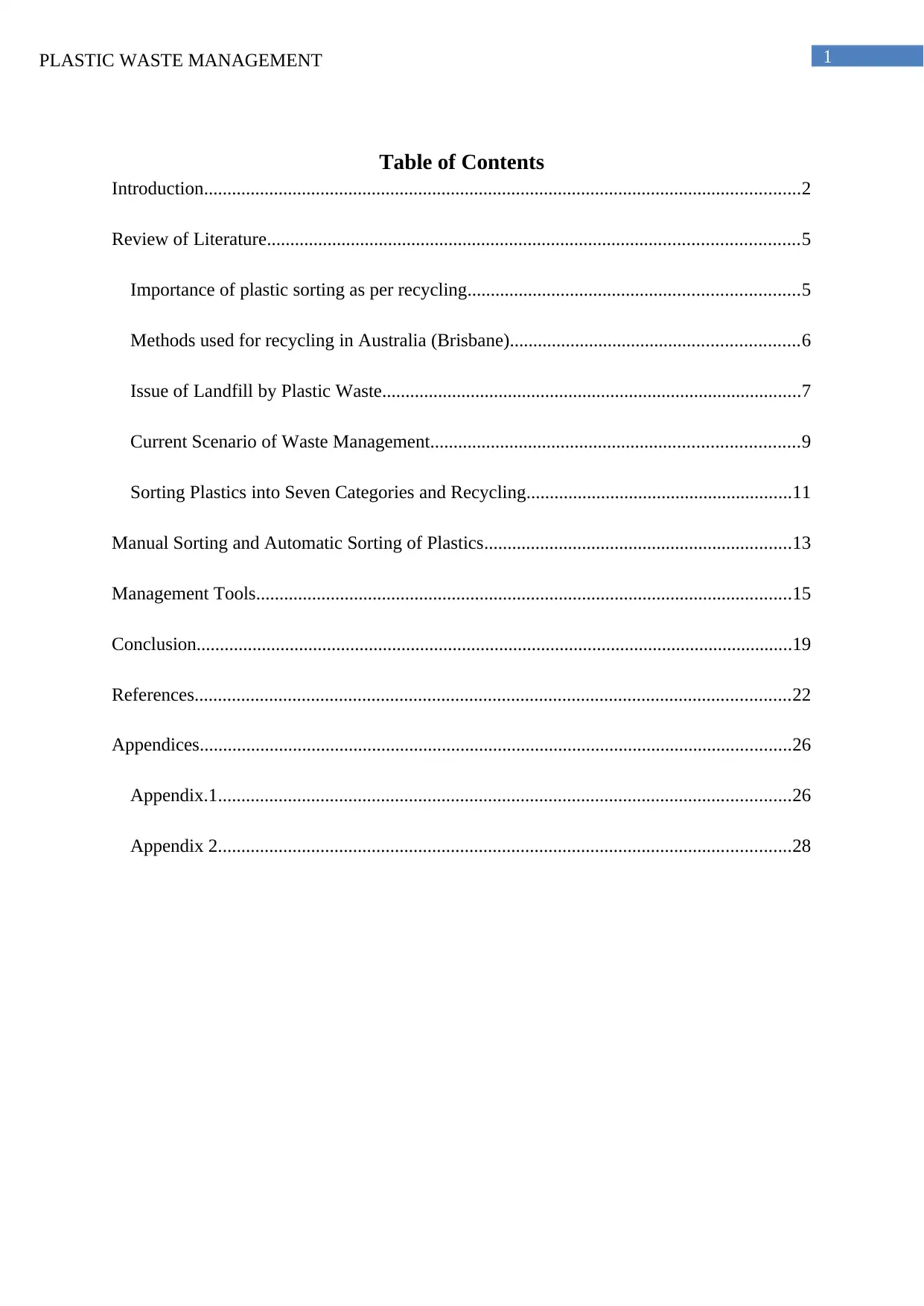
1PLASTIC WASTE MANAGEMENT
Table of Contents
Introduction................................................................................................................................2
Review of Literature..................................................................................................................5
Importance of plastic sorting as per recycling.......................................................................5
Methods used for recycling in Australia (Brisbane)..............................................................6
Issue of Landfill by Plastic Waste..........................................................................................7
Current Scenario of Waste Management...............................................................................9
Sorting Plastics into Seven Categories and Recycling.........................................................11
Manual Sorting and Automatic Sorting of Plastics..................................................................13
Management Tools...................................................................................................................15
Conclusion................................................................................................................................19
References................................................................................................................................22
Appendices...............................................................................................................................26
Appendix.1...........................................................................................................................26
Appendix 2...........................................................................................................................28
Table of Contents
Introduction................................................................................................................................2
Review of Literature..................................................................................................................5
Importance of plastic sorting as per recycling.......................................................................5
Methods used for recycling in Australia (Brisbane)..............................................................6
Issue of Landfill by Plastic Waste..........................................................................................7
Current Scenario of Waste Management...............................................................................9
Sorting Plastics into Seven Categories and Recycling.........................................................11
Manual Sorting and Automatic Sorting of Plastics..................................................................13
Management Tools...................................................................................................................15
Conclusion................................................................................................................................19
References................................................................................................................................22
Appendices...............................................................................................................................26
Appendix.1...........................................................................................................................26
Appendix 2...........................................................................................................................28
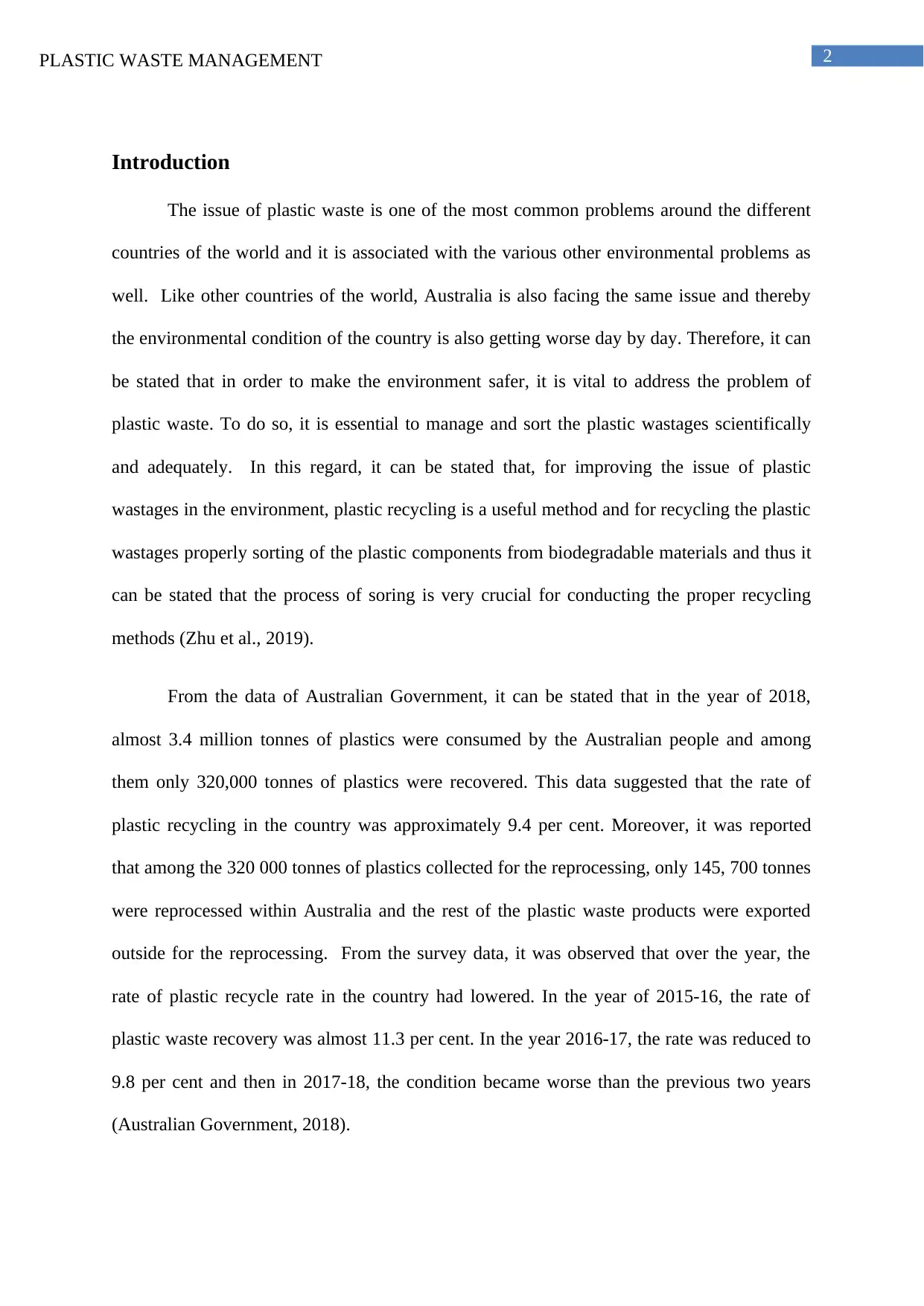
2PLASTIC WASTE MANAGEMENT
Introduction
The issue of plastic waste is one of the most common problems around the different
countries of the world and it is associated with the various other environmental problems as
well. Like other countries of the world, Australia is also facing the same issue and thereby
the environmental condition of the country is also getting worse day by day. Therefore, it can
be stated that in order to make the environment safer, it is vital to address the problem of
plastic waste. To do so, it is essential to manage and sort the plastic wastages scientifically
and adequately. In this regard, it can be stated that, for improving the issue of plastic
wastages in the environment, plastic recycling is a useful method and for recycling the plastic
wastages properly sorting of the plastic components from biodegradable materials and thus it
can be stated that the process of soring is very crucial for conducting the proper recycling
methods (Zhu et al., 2019).
From the data of Australian Government, it can be stated that in the year of 2018,
almost 3.4 million tonnes of plastics were consumed by the Australian people and among
them only 320,000 tonnes of plastics were recovered. This data suggested that the rate of
plastic recycling in the country was approximately 9.4 per cent. Moreover, it was reported
that among the 320 000 tonnes of plastics collected for the reprocessing, only 145, 700 tonnes
were reprocessed within Australia and the rest of the plastic waste products were exported
outside for the reprocessing. From the survey data, it was observed that over the year, the
rate of plastic recycle rate in the country had lowered. In the year of 2015-16, the rate of
plastic waste recovery was almost 11.3 per cent. In the year 2016-17, the rate was reduced to
9.8 per cent and then in 2017-18, the condition became worse than the previous two years
(Australian Government, 2018).
Introduction
The issue of plastic waste is one of the most common problems around the different
countries of the world and it is associated with the various other environmental problems as
well. Like other countries of the world, Australia is also facing the same issue and thereby
the environmental condition of the country is also getting worse day by day. Therefore, it can
be stated that in order to make the environment safer, it is vital to address the problem of
plastic waste. To do so, it is essential to manage and sort the plastic wastages scientifically
and adequately. In this regard, it can be stated that, for improving the issue of plastic
wastages in the environment, plastic recycling is a useful method and for recycling the plastic
wastages properly sorting of the plastic components from biodegradable materials and thus it
can be stated that the process of soring is very crucial for conducting the proper recycling
methods (Zhu et al., 2019).
From the data of Australian Government, it can be stated that in the year of 2018,
almost 3.4 million tonnes of plastics were consumed by the Australian people and among
them only 320,000 tonnes of plastics were recovered. This data suggested that the rate of
plastic recycling in the country was approximately 9.4 per cent. Moreover, it was reported
that among the 320 000 tonnes of plastics collected for the reprocessing, only 145, 700 tonnes
were reprocessed within Australia and the rest of the plastic waste products were exported
outside for the reprocessing. From the survey data, it was observed that over the year, the
rate of plastic recycle rate in the country had lowered. In the year of 2015-16, the rate of
plastic waste recovery was almost 11.3 per cent. In the year 2016-17, the rate was reduced to
9.8 per cent and then in 2017-18, the condition became worse than the previous two years
(Australian Government, 2018).
⊘ This is a preview!⊘
Do you want full access?
Subscribe today to unlock all pages.

Trusted by 1+ million students worldwide
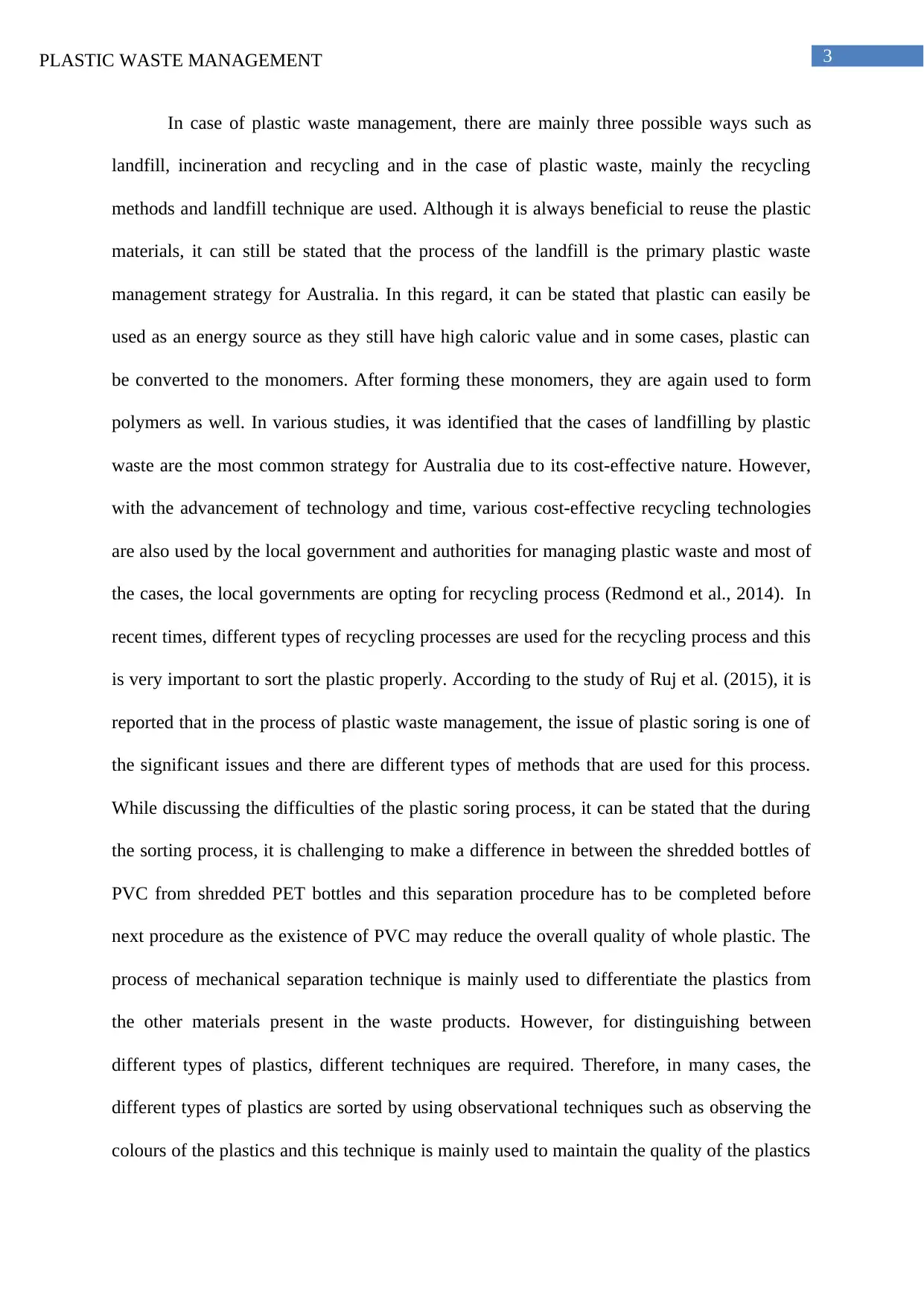
3PLASTIC WASTE MANAGEMENT
In case of plastic waste management, there are mainly three possible ways such as
landfill, incineration and recycling and in the case of plastic waste, mainly the recycling
methods and landfill technique are used. Although it is always beneficial to reuse the plastic
materials, it can still be stated that the process of the landfill is the primary plastic waste
management strategy for Australia. In this regard, it can be stated that plastic can easily be
used as an energy source as they still have high caloric value and in some cases, plastic can
be converted to the monomers. After forming these monomers, they are again used to form
polymers as well. In various studies, it was identified that the cases of landfilling by plastic
waste are the most common strategy for Australia due to its cost-effective nature. However,
with the advancement of technology and time, various cost-effective recycling technologies
are also used by the local government and authorities for managing plastic waste and most of
the cases, the local governments are opting for recycling process (Redmond et al., 2014). In
recent times, different types of recycling processes are used for the recycling process and this
is very important to sort the plastic properly. According to the study of Ruj et al. (2015), it is
reported that in the process of plastic waste management, the issue of plastic soring is one of
the significant issues and there are different types of methods that are used for this process.
While discussing the difficulties of the plastic soring process, it can be stated that the during
the sorting process, it is challenging to make a difference in between the shredded bottles of
PVC from shredded PET bottles and this separation procedure has to be completed before
next procedure as the existence of PVC may reduce the overall quality of whole plastic. The
process of mechanical separation technique is mainly used to differentiate the plastics from
the other materials present in the waste products. However, for distinguishing between
different types of plastics, different techniques are required. Therefore, in many cases, the
different types of plastics are sorted by using observational techniques such as observing the
colours of the plastics and this technique is mainly used to maintain the quality of the plastics
In case of plastic waste management, there are mainly three possible ways such as
landfill, incineration and recycling and in the case of plastic waste, mainly the recycling
methods and landfill technique are used. Although it is always beneficial to reuse the plastic
materials, it can still be stated that the process of the landfill is the primary plastic waste
management strategy for Australia. In this regard, it can be stated that plastic can easily be
used as an energy source as they still have high caloric value and in some cases, plastic can
be converted to the monomers. After forming these monomers, they are again used to form
polymers as well. In various studies, it was identified that the cases of landfilling by plastic
waste are the most common strategy for Australia due to its cost-effective nature. However,
with the advancement of technology and time, various cost-effective recycling technologies
are also used by the local government and authorities for managing plastic waste and most of
the cases, the local governments are opting for recycling process (Redmond et al., 2014). In
recent times, different types of recycling processes are used for the recycling process and this
is very important to sort the plastic properly. According to the study of Ruj et al. (2015), it is
reported that in the process of plastic waste management, the issue of plastic soring is one of
the significant issues and there are different types of methods that are used for this process.
While discussing the difficulties of the plastic soring process, it can be stated that the during
the sorting process, it is challenging to make a difference in between the shredded bottles of
PVC from shredded PET bottles and this separation procedure has to be completed before
next procedure as the existence of PVC may reduce the overall quality of whole plastic. The
process of mechanical separation technique is mainly used to differentiate the plastics from
the other materials present in the waste products. However, for distinguishing between
different types of plastics, different techniques are required. Therefore, in many cases, the
different types of plastics are sorted by using observational techniques such as observing the
colours of the plastics and this technique is mainly used to maintain the quality of the plastics
Paraphrase This Document
Need a fresh take? Get an instant paraphrase of this document with our AI Paraphraser
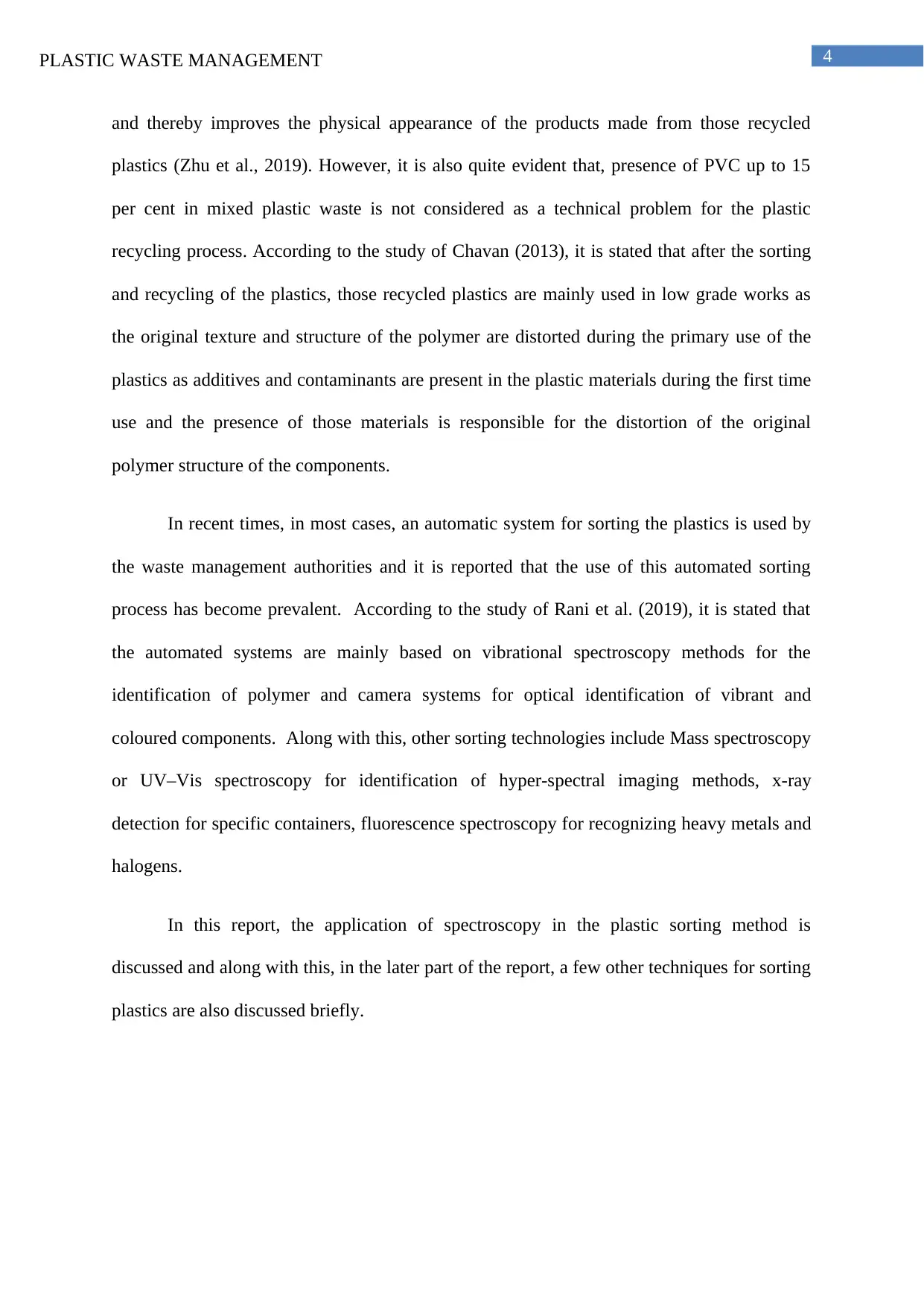
4PLASTIC WASTE MANAGEMENT
and thereby improves the physical appearance of the products made from those recycled
plastics (Zhu et al., 2019). However, it is also quite evident that, presence of PVC up to 15
per cent in mixed plastic waste is not considered as a technical problem for the plastic
recycling process. According to the study of Chavan (2013), it is stated that after the sorting
and recycling of the plastics, those recycled plastics are mainly used in low grade works as
the original texture and structure of the polymer are distorted during the primary use of the
plastics as additives and contaminants are present in the plastic materials during the first time
use and the presence of those materials is responsible for the distortion of the original
polymer structure of the components.
In recent times, in most cases, an automatic system for sorting the plastics is used by
the waste management authorities and it is reported that the use of this automated sorting
process has become prevalent. According to the study of Rani et al. (2019), it is stated that
the automated systems are mainly based on vibrational spectroscopy methods for the
identification of polymer and camera systems for optical identification of vibrant and
coloured components. Along with this, other sorting technologies include Mass spectroscopy
or UV–Vis spectroscopy for identification of hyper-spectral imaging methods, x-ray
detection for specific containers, fluorescence spectroscopy for recognizing heavy metals and
halogens.
In this report, the application of spectroscopy in the plastic sorting method is
discussed and along with this, in the later part of the report, a few other techniques for sorting
plastics are also discussed briefly.
and thereby improves the physical appearance of the products made from those recycled
plastics (Zhu et al., 2019). However, it is also quite evident that, presence of PVC up to 15
per cent in mixed plastic waste is not considered as a technical problem for the plastic
recycling process. According to the study of Chavan (2013), it is stated that after the sorting
and recycling of the plastics, those recycled plastics are mainly used in low grade works as
the original texture and structure of the polymer are distorted during the primary use of the
plastics as additives and contaminants are present in the plastic materials during the first time
use and the presence of those materials is responsible for the distortion of the original
polymer structure of the components.
In recent times, in most cases, an automatic system for sorting the plastics is used by
the waste management authorities and it is reported that the use of this automated sorting
process has become prevalent. According to the study of Rani et al. (2019), it is stated that
the automated systems are mainly based on vibrational spectroscopy methods for the
identification of polymer and camera systems for optical identification of vibrant and
coloured components. Along with this, other sorting technologies include Mass spectroscopy
or UV–Vis spectroscopy for identification of hyper-spectral imaging methods, x-ray
detection for specific containers, fluorescence spectroscopy for recognizing heavy metals and
halogens.
In this report, the application of spectroscopy in the plastic sorting method is
discussed and along with this, in the later part of the report, a few other techniques for sorting
plastics are also discussed briefly.
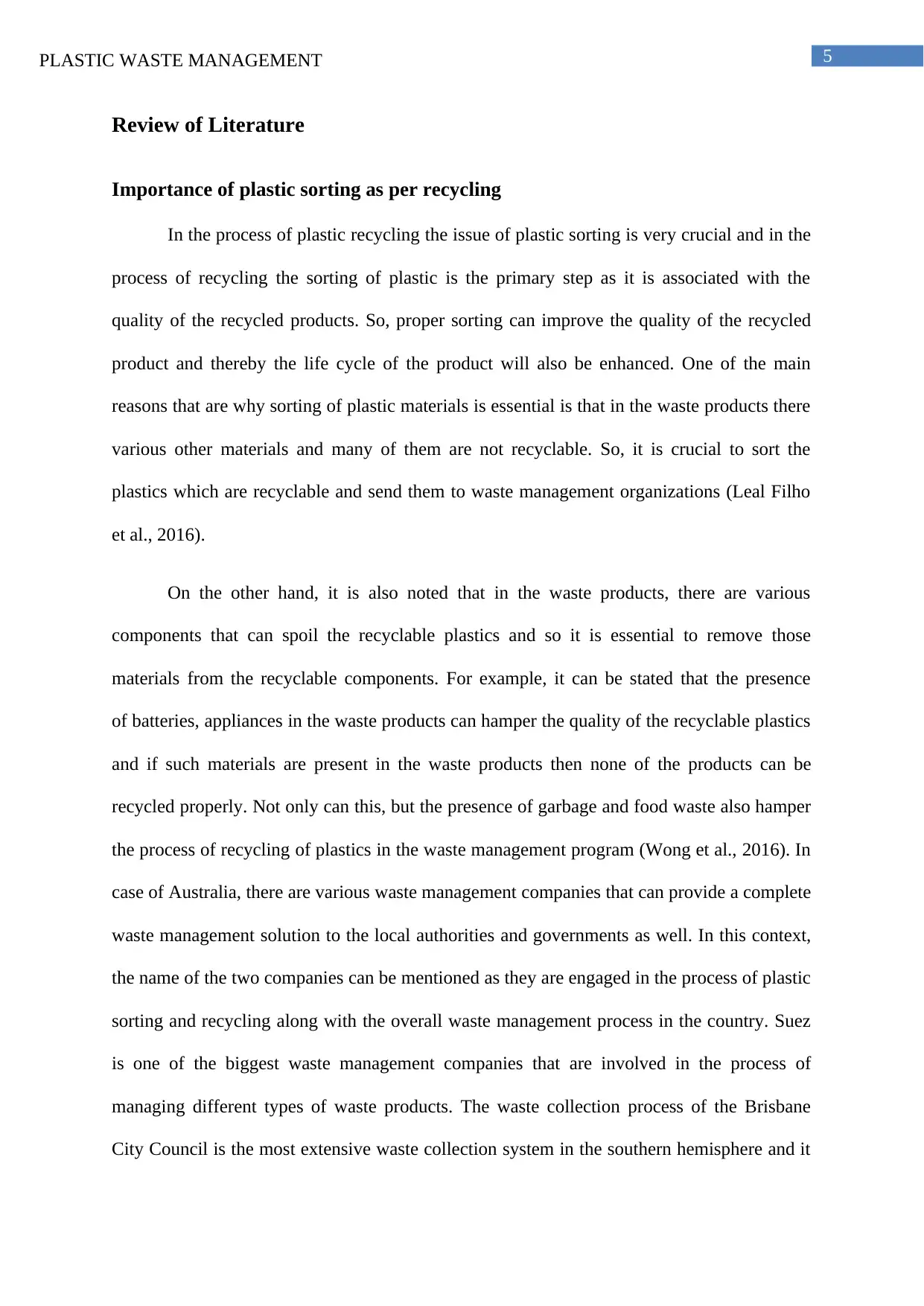
5PLASTIC WASTE MANAGEMENT
Review of Literature
Importance of plastic sorting as per recycling
In the process of plastic recycling the issue of plastic sorting is very crucial and in the
process of recycling the sorting of plastic is the primary step as it is associated with the
quality of the recycled products. So, proper sorting can improve the quality of the recycled
product and thereby the life cycle of the product will also be enhanced. One of the main
reasons that are why sorting of plastic materials is essential is that in the waste products there
various other materials and many of them are not recyclable. So, it is crucial to sort the
plastics which are recyclable and send them to waste management organizations (Leal Filho
et al., 2016).
On the other hand, it is also noted that in the waste products, there are various
components that can spoil the recyclable plastics and so it is essential to remove those
materials from the recyclable components. For example, it can be stated that the presence
of batteries, appliances in the waste products can hamper the quality of the recyclable plastics
and if such materials are present in the waste products then none of the products can be
recycled properly. Not only can this, but the presence of garbage and food waste also hamper
the process of recycling of plastics in the waste management program (Wong et al., 2016). In
case of Australia, there are various waste management companies that can provide a complete
waste management solution to the local authorities and governments as well. In this context,
the name of the two companies can be mentioned as they are engaged in the process of plastic
sorting and recycling along with the overall waste management process in the country. Suez
is one of the biggest waste management companies that are involved in the process of
managing different types of waste products. The waste collection process of the Brisbane
City Council is the most extensive waste collection system in the southern hemisphere and it
Review of Literature
Importance of plastic sorting as per recycling
In the process of plastic recycling the issue of plastic sorting is very crucial and in the
process of recycling the sorting of plastic is the primary step as it is associated with the
quality of the recycled products. So, proper sorting can improve the quality of the recycled
product and thereby the life cycle of the product will also be enhanced. One of the main
reasons that are why sorting of plastic materials is essential is that in the waste products there
various other materials and many of them are not recyclable. So, it is crucial to sort the
plastics which are recyclable and send them to waste management organizations (Leal Filho
et al., 2016).
On the other hand, it is also noted that in the waste products, there are various
components that can spoil the recyclable plastics and so it is essential to remove those
materials from the recyclable components. For example, it can be stated that the presence
of batteries, appliances in the waste products can hamper the quality of the recyclable plastics
and if such materials are present in the waste products then none of the products can be
recycled properly. Not only can this, but the presence of garbage and food waste also hamper
the process of recycling of plastics in the waste management program (Wong et al., 2016). In
case of Australia, there are various waste management companies that can provide a complete
waste management solution to the local authorities and governments as well. In this context,
the name of the two companies can be mentioned as they are engaged in the process of plastic
sorting and recycling along with the overall waste management process in the country. Suez
is one of the biggest waste management companies that are involved in the process of
managing different types of waste products. The waste collection process of the Brisbane
City Council is the most extensive waste collection system in the southern hemisphere and it
⊘ This is a preview!⊘
Do you want full access?
Subscribe today to unlock all pages.

Trusted by 1+ million students worldwide
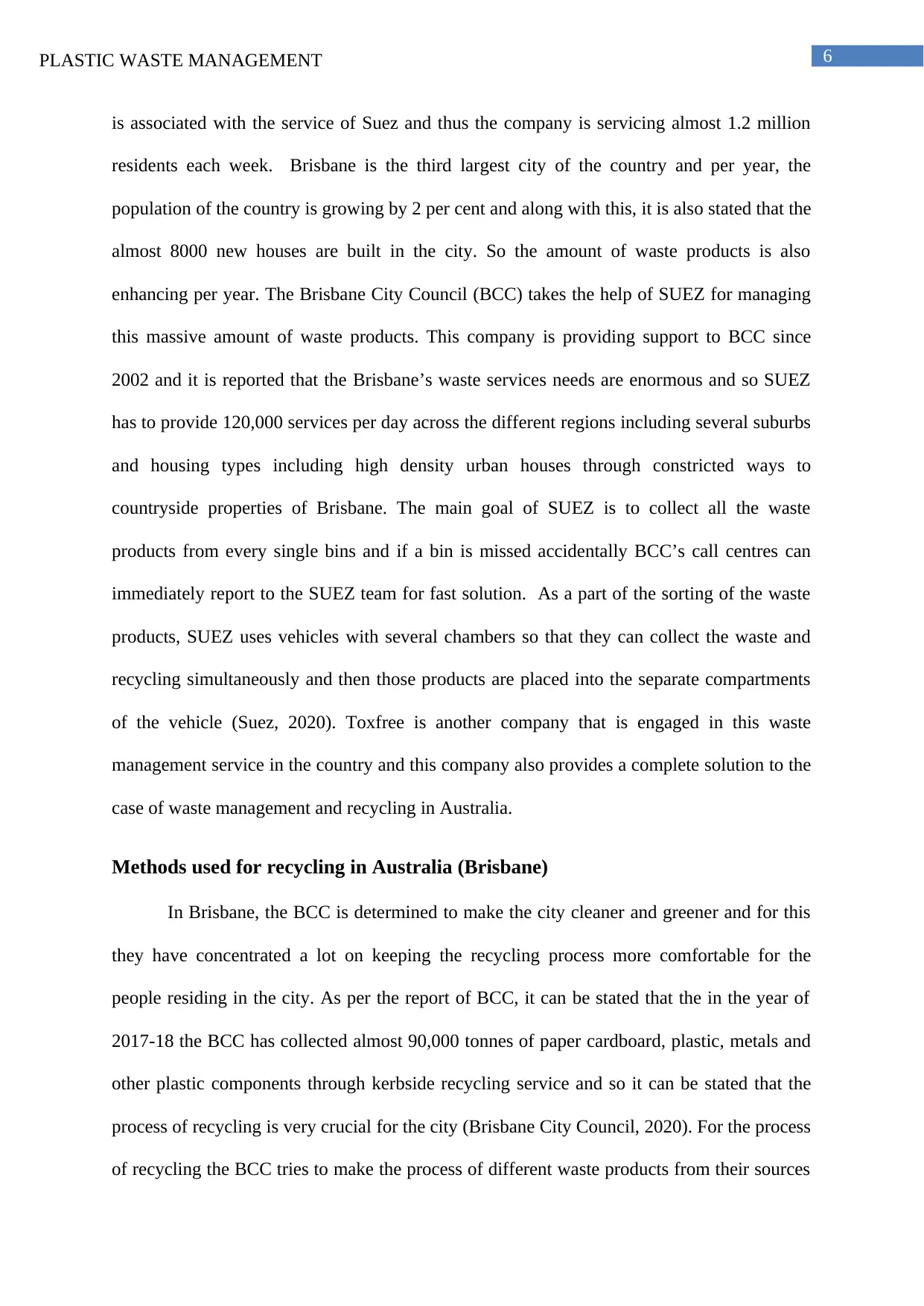
6PLASTIC WASTE MANAGEMENT
is associated with the service of Suez and thus the company is servicing almost 1.2 million
residents each week. Brisbane is the third largest city of the country and per year, the
population of the country is growing by 2 per cent and along with this, it is also stated that the
almost 8000 new houses are built in the city. So the amount of waste products is also
enhancing per year. The Brisbane City Council (BCC) takes the help of SUEZ for managing
this massive amount of waste products. This company is providing support to BCC since
2002 and it is reported that the Brisbane’s waste services needs are enormous and so SUEZ
has to provide 120,000 services per day across the different regions including several suburbs
and housing types including high density urban houses through constricted ways to
countryside properties of Brisbane. The main goal of SUEZ is to collect all the waste
products from every single bins and if a bin is missed accidentally BCC’s call centres can
immediately report to the SUEZ team for fast solution. As a part of the sorting of the waste
products, SUEZ uses vehicles with several chambers so that they can collect the waste and
recycling simultaneously and then those products are placed into the separate compartments
of the vehicle (Suez, 2020). Toxfree is another company that is engaged in this waste
management service in the country and this company also provides a complete solution to the
case of waste management and recycling in Australia.
Methods used for recycling in Australia (Brisbane)
In Brisbane, the BCC is determined to make the city cleaner and greener and for this
they have concentrated a lot on keeping the recycling process more comfortable for the
people residing in the city. As per the report of BCC, it can be stated that the in the year of
2017-18 the BCC has collected almost 90,000 tonnes of paper cardboard, plastic, metals and
other plastic components through kerbside recycling service and so it can be stated that the
process of recycling is very crucial for the city (Brisbane City Council, 2020). For the process
of recycling the BCC tries to make the process of different waste products from their sources
is associated with the service of Suez and thus the company is servicing almost 1.2 million
residents each week. Brisbane is the third largest city of the country and per year, the
population of the country is growing by 2 per cent and along with this, it is also stated that the
almost 8000 new houses are built in the city. So the amount of waste products is also
enhancing per year. The Brisbane City Council (BCC) takes the help of SUEZ for managing
this massive amount of waste products. This company is providing support to BCC since
2002 and it is reported that the Brisbane’s waste services needs are enormous and so SUEZ
has to provide 120,000 services per day across the different regions including several suburbs
and housing types including high density urban houses through constricted ways to
countryside properties of Brisbane. The main goal of SUEZ is to collect all the waste
products from every single bins and if a bin is missed accidentally BCC’s call centres can
immediately report to the SUEZ team for fast solution. As a part of the sorting of the waste
products, SUEZ uses vehicles with several chambers so that they can collect the waste and
recycling simultaneously and then those products are placed into the separate compartments
of the vehicle (Suez, 2020). Toxfree is another company that is engaged in this waste
management service in the country and this company also provides a complete solution to the
case of waste management and recycling in Australia.
Methods used for recycling in Australia (Brisbane)
In Brisbane, the BCC is determined to make the city cleaner and greener and for this
they have concentrated a lot on keeping the recycling process more comfortable for the
people residing in the city. As per the report of BCC, it can be stated that the in the year of
2017-18 the BCC has collected almost 90,000 tonnes of paper cardboard, plastic, metals and
other plastic components through kerbside recycling service and so it can be stated that the
process of recycling is very crucial for the city (Brisbane City Council, 2020). For the process
of recycling the BCC tries to make the process of different waste products from their sources
Paraphrase This Document
Need a fresh take? Get an instant paraphrase of this document with our AI Paraphraser
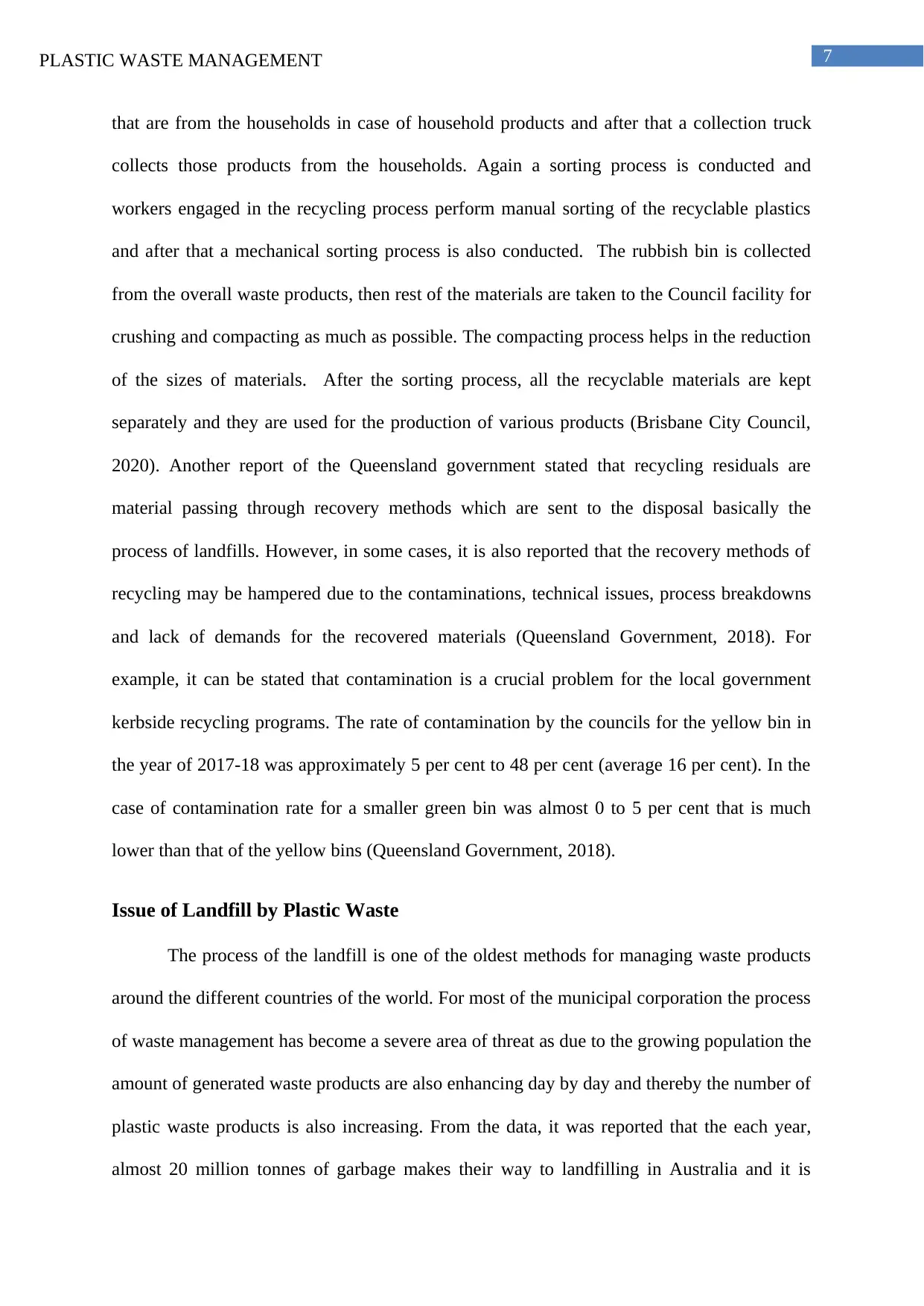
7PLASTIC WASTE MANAGEMENT
that are from the households in case of household products and after that a collection truck
collects those products from the households. Again a sorting process is conducted and
workers engaged in the recycling process perform manual sorting of the recyclable plastics
and after that a mechanical sorting process is also conducted. The rubbish bin is collected
from the overall waste products, then rest of the materials are taken to the Council facility for
crushing and compacting as much as possible. The compacting process helps in the reduction
of the sizes of materials. After the sorting process, all the recyclable materials are kept
separately and they are used for the production of various products (Brisbane City Council,
2020). Another report of the Queensland government stated that recycling residuals are
material passing through recovery methods which are sent to the disposal basically the
process of landfills. However, in some cases, it is also reported that the recovery methods of
recycling may be hampered due to the contaminations, technical issues, process breakdowns
and lack of demands for the recovered materials (Queensland Government, 2018). For
example, it can be stated that contamination is a crucial problem for the local government
kerbside recycling programs. The rate of contamination by the councils for the yellow bin in
the year of 2017-18 was approximately 5 per cent to 48 per cent (average 16 per cent). In the
case of contamination rate for a smaller green bin was almost 0 to 5 per cent that is much
lower than that of the yellow bins (Queensland Government, 2018).
Issue of Landfill by Plastic Waste
The process of the landfill is one of the oldest methods for managing waste products
around the different countries of the world. For most of the municipal corporation the process
of waste management has become a severe area of threat as due to the growing population the
amount of generated waste products are also enhancing day by day and thereby the number of
plastic waste products is also increasing. From the data, it was reported that the each year,
almost 20 million tonnes of garbage makes their way to landfilling in Australia and it is
that are from the households in case of household products and after that a collection truck
collects those products from the households. Again a sorting process is conducted and
workers engaged in the recycling process perform manual sorting of the recyclable plastics
and after that a mechanical sorting process is also conducted. The rubbish bin is collected
from the overall waste products, then rest of the materials are taken to the Council facility for
crushing and compacting as much as possible. The compacting process helps in the reduction
of the sizes of materials. After the sorting process, all the recyclable materials are kept
separately and they are used for the production of various products (Brisbane City Council,
2020). Another report of the Queensland government stated that recycling residuals are
material passing through recovery methods which are sent to the disposal basically the
process of landfills. However, in some cases, it is also reported that the recovery methods of
recycling may be hampered due to the contaminations, technical issues, process breakdowns
and lack of demands for the recovered materials (Queensland Government, 2018). For
example, it can be stated that contamination is a crucial problem for the local government
kerbside recycling programs. The rate of contamination by the councils for the yellow bin in
the year of 2017-18 was approximately 5 per cent to 48 per cent (average 16 per cent). In the
case of contamination rate for a smaller green bin was almost 0 to 5 per cent that is much
lower than that of the yellow bins (Queensland Government, 2018).
Issue of Landfill by Plastic Waste
The process of the landfill is one of the oldest methods for managing waste products
around the different countries of the world. For most of the municipal corporation the process
of waste management has become a severe area of threat as due to the growing population the
amount of generated waste products are also enhancing day by day and thereby the number of
plastic waste products is also increasing. From the data, it was reported that the each year,
almost 20 million tonnes of garbage makes their way to landfilling in Australia and it is
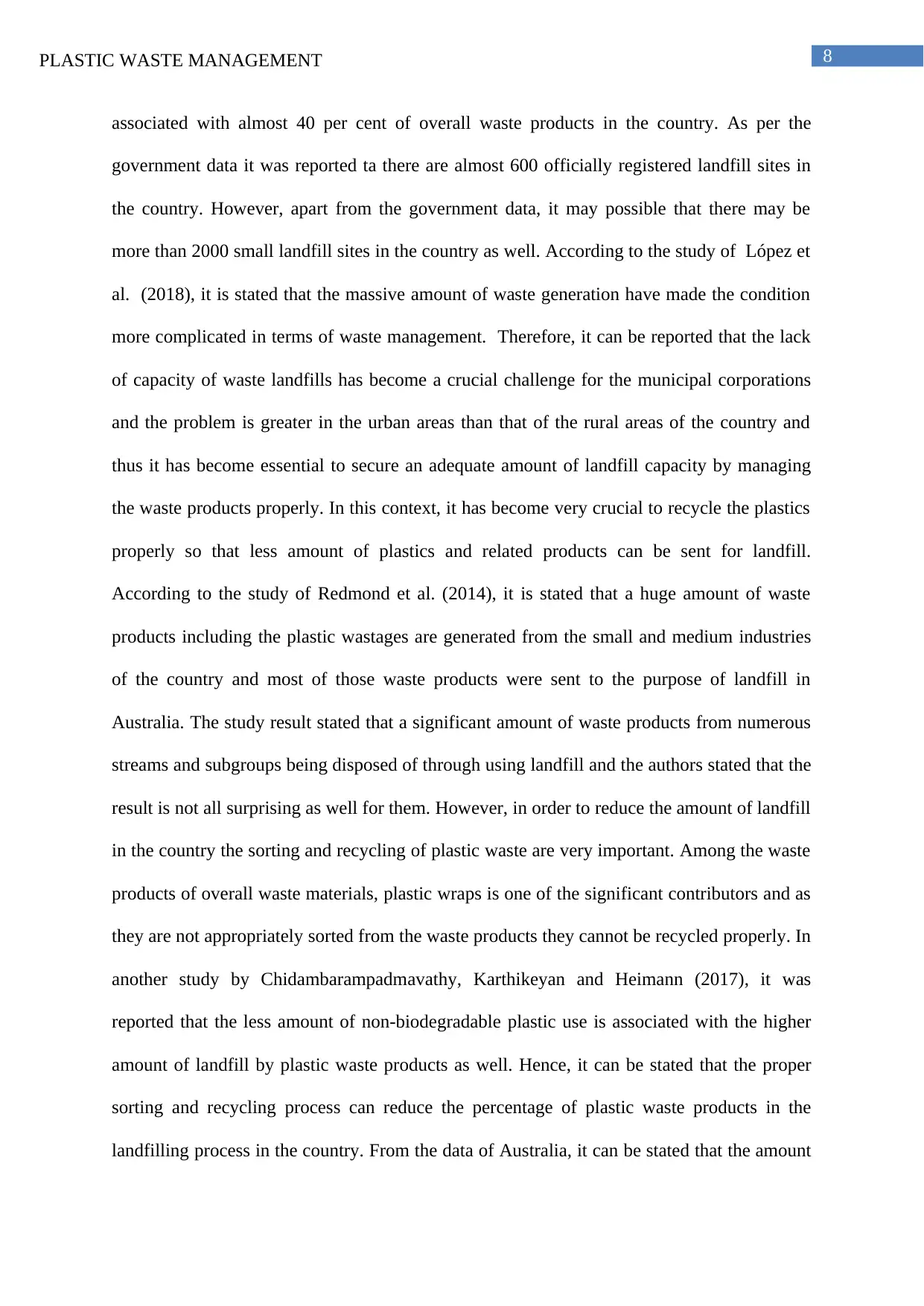
8PLASTIC WASTE MANAGEMENT
associated with almost 40 per cent of overall waste products in the country. As per the
government data it was reported ta there are almost 600 officially registered landfill sites in
the country. However, apart from the government data, it may possible that there may be
more than 2000 small landfill sites in the country as well. According to the study of López et
al. (2018), it is stated that the massive amount of waste generation have made the condition
more complicated in terms of waste management. Therefore, it can be reported that the lack
of capacity of waste landfills has become a crucial challenge for the municipal corporations
and the problem is greater in the urban areas than that of the rural areas of the country and
thus it has become essential to secure an adequate amount of landfill capacity by managing
the waste products properly. In this context, it has become very crucial to recycle the plastics
properly so that less amount of plastics and related products can be sent for landfill.
According to the study of Redmond et al. (2014), it is stated that a huge amount of waste
products including the plastic wastages are generated from the small and medium industries
of the country and most of those waste products were sent to the purpose of landfill in
Australia. The study result stated that a significant amount of waste products from numerous
streams and subgroups being disposed of through using landfill and the authors stated that the
result is not all surprising as well for them. However, in order to reduce the amount of landfill
in the country the sorting and recycling of plastic waste are very important. Among the waste
products of overall waste materials, plastic wraps is one of the significant contributors and as
they are not appropriately sorted from the waste products they cannot be recycled properly. In
another study by Chidambarampadmavathy, Karthikeyan and Heimann (2017), it was
reported that the less amount of non-biodegradable plastic use is associated with the higher
amount of landfill by plastic waste products as well. Hence, it can be stated that the proper
sorting and recycling process can reduce the percentage of plastic waste products in the
landfilling process in the country. From the data of Australia, it can be stated that the amount
associated with almost 40 per cent of overall waste products in the country. As per the
government data it was reported ta there are almost 600 officially registered landfill sites in
the country. However, apart from the government data, it may possible that there may be
more than 2000 small landfill sites in the country as well. According to the study of López et
al. (2018), it is stated that the massive amount of waste generation have made the condition
more complicated in terms of waste management. Therefore, it can be reported that the lack
of capacity of waste landfills has become a crucial challenge for the municipal corporations
and the problem is greater in the urban areas than that of the rural areas of the country and
thus it has become essential to secure an adequate amount of landfill capacity by managing
the waste products properly. In this context, it has become very crucial to recycle the plastics
properly so that less amount of plastics and related products can be sent for landfill.
According to the study of Redmond et al. (2014), it is stated that a huge amount of waste
products including the plastic wastages are generated from the small and medium industries
of the country and most of those waste products were sent to the purpose of landfill in
Australia. The study result stated that a significant amount of waste products from numerous
streams and subgroups being disposed of through using landfill and the authors stated that the
result is not all surprising as well for them. However, in order to reduce the amount of landfill
in the country the sorting and recycling of plastic waste are very important. Among the waste
products of overall waste materials, plastic wraps is one of the significant contributors and as
they are not appropriately sorted from the waste products they cannot be recycled properly. In
another study by Chidambarampadmavathy, Karthikeyan and Heimann (2017), it was
reported that the less amount of non-biodegradable plastic use is associated with the higher
amount of landfill by plastic waste products as well. Hence, it can be stated that the proper
sorting and recycling process can reduce the percentage of plastic waste products in the
landfilling process in the country. From the data of Australia, it can be stated that the amount
⊘ This is a preview!⊘
Do you want full access?
Subscribe today to unlock all pages.

Trusted by 1+ million students worldwide
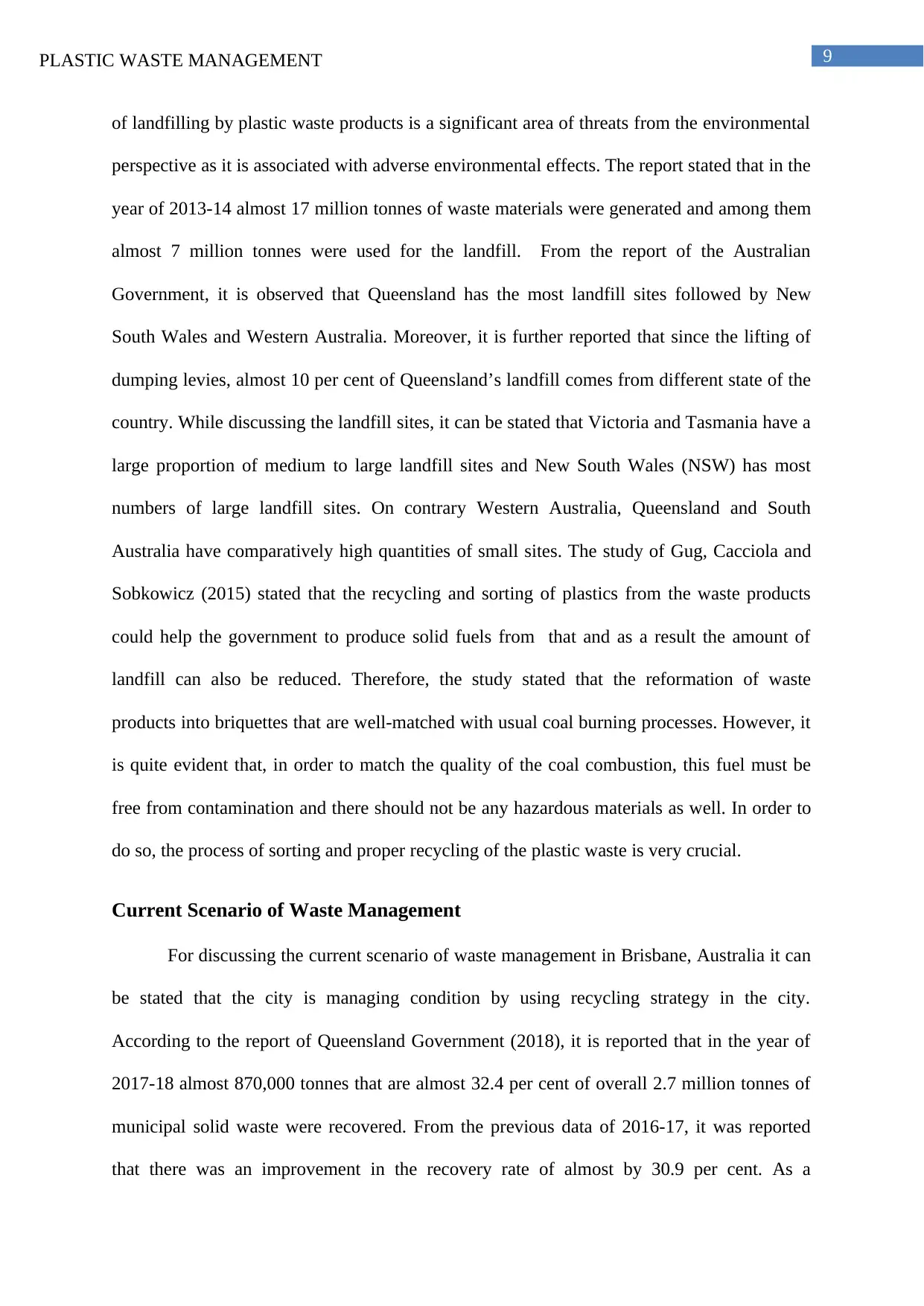
9PLASTIC WASTE MANAGEMENT
of landfilling by plastic waste products is a significant area of threats from the environmental
perspective as it is associated with adverse environmental effects. The report stated that in the
year of 2013-14 almost 17 million tonnes of waste materials were generated and among them
almost 7 million tonnes were used for the landfill. From the report of the Australian
Government, it is observed that Queensland has the most landfill sites followed by New
South Wales and Western Australia. Moreover, it is further reported that since the lifting of
dumping levies, almost 10 per cent of Queensland’s landfill comes from different state of the
country. While discussing the landfill sites, it can be stated that Victoria and Tasmania have a
large proportion of medium to large landfill sites and New South Wales (NSW) has most
numbers of large landfill sites. On contrary Western Australia, Queensland and South
Australia have comparatively high quantities of small sites. The study of Gug, Cacciola and
Sobkowicz (2015) stated that the recycling and sorting of plastics from the waste products
could help the government to produce solid fuels from that and as a result the amount of
landfill can also be reduced. Therefore, the study stated that the reformation of waste
products into briquettes that are well-matched with usual coal burning processes. However, it
is quite evident that, in order to match the quality of the coal combustion, this fuel must be
free from contamination and there should not be any hazardous materials as well. In order to
do so, the process of sorting and proper recycling of the plastic waste is very crucial.
Current Scenario of Waste Management
For discussing the current scenario of waste management in Brisbane, Australia it can
be stated that the city is managing condition by using recycling strategy in the city.
According to the report of Queensland Government (2018), it is reported that in the year of
2017-18 almost 870,000 tonnes that are almost 32.4 per cent of overall 2.7 million tonnes of
municipal solid waste were recovered. From the previous data of 2016-17, it was reported
that there was an improvement in the recovery rate of almost by 30.9 per cent. As a
of landfilling by plastic waste products is a significant area of threats from the environmental
perspective as it is associated with adverse environmental effects. The report stated that in the
year of 2013-14 almost 17 million tonnes of waste materials were generated and among them
almost 7 million tonnes were used for the landfill. From the report of the Australian
Government, it is observed that Queensland has the most landfill sites followed by New
South Wales and Western Australia. Moreover, it is further reported that since the lifting of
dumping levies, almost 10 per cent of Queensland’s landfill comes from different state of the
country. While discussing the landfill sites, it can be stated that Victoria and Tasmania have a
large proportion of medium to large landfill sites and New South Wales (NSW) has most
numbers of large landfill sites. On contrary Western Australia, Queensland and South
Australia have comparatively high quantities of small sites. The study of Gug, Cacciola and
Sobkowicz (2015) stated that the recycling and sorting of plastics from the waste products
could help the government to produce solid fuels from that and as a result the amount of
landfill can also be reduced. Therefore, the study stated that the reformation of waste
products into briquettes that are well-matched with usual coal burning processes. However, it
is quite evident that, in order to match the quality of the coal combustion, this fuel must be
free from contamination and there should not be any hazardous materials as well. In order to
do so, the process of sorting and proper recycling of the plastic waste is very crucial.
Current Scenario of Waste Management
For discussing the current scenario of waste management in Brisbane, Australia it can
be stated that the city is managing condition by using recycling strategy in the city.
According to the report of Queensland Government (2018), it is reported that in the year of
2017-18 almost 870,000 tonnes that are almost 32.4 per cent of overall 2.7 million tonnes of
municipal solid waste were recovered. From the previous data of 2016-17, it was reported
that there was an improvement in the recovery rate of almost by 30.9 per cent. As a
Paraphrase This Document
Need a fresh take? Get an instant paraphrase of this document with our AI Paraphraser
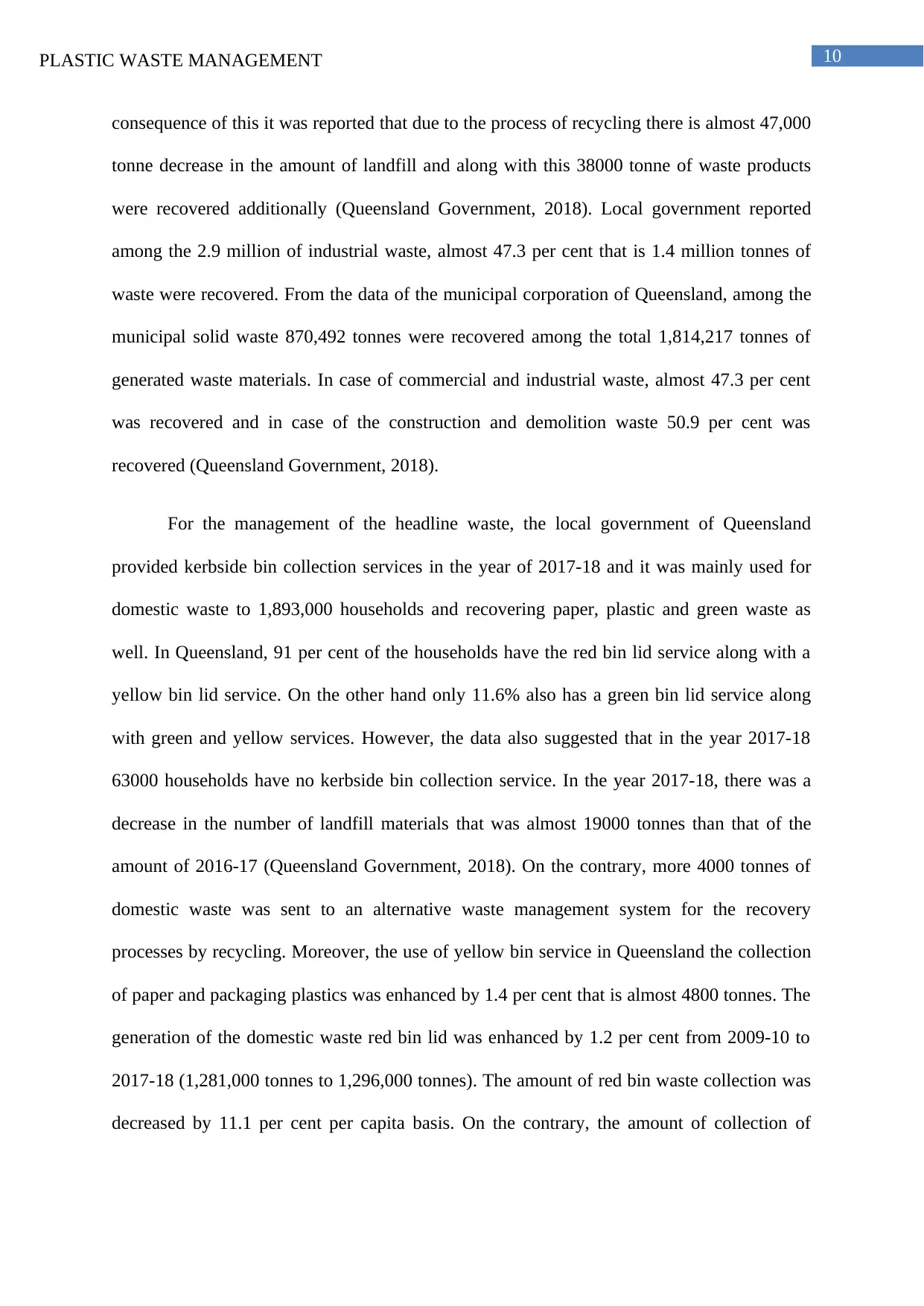
10PLASTIC WASTE MANAGEMENT
consequence of this it was reported that due to the process of recycling there is almost 47,000
tonne decrease in the amount of landfill and along with this 38000 tonne of waste products
were recovered additionally (Queensland Government, 2018). Local government reported
among the 2.9 million of industrial waste, almost 47.3 per cent that is 1.4 million tonnes of
waste were recovered. From the data of the municipal corporation of Queensland, among the
municipal solid waste 870,492 tonnes were recovered among the total 1,814,217 tonnes of
generated waste materials. In case of commercial and industrial waste, almost 47.3 per cent
was recovered and in case of the construction and demolition waste 50.9 per cent was
recovered (Queensland Government, 2018).
For the management of the headline waste, the local government of Queensland
provided kerbside bin collection services in the year of 2017-18 and it was mainly used for
domestic waste to 1,893,000 households and recovering paper, plastic and green waste as
well. In Queensland, 91 per cent of the households have the red bin lid service along with a
yellow bin lid service. On the other hand only 11.6% also has a green bin lid service along
with green and yellow services. However, the data also suggested that in the year 2017-18
63000 households have no kerbside bin collection service. In the year 2017-18, there was a
decrease in the number of landfill materials that was almost 19000 tonnes than that of the
amount of 2016-17 (Queensland Government, 2018). On the contrary, more 4000 tonnes of
domestic waste was sent to an alternative waste management system for the recovery
processes by recycling. Moreover, the use of yellow bin service in Queensland the collection
of paper and packaging plastics was enhanced by 1.4 per cent that is almost 4800 tonnes. The
generation of the domestic waste red bin lid was enhanced by 1.2 per cent from 2009-10 to
2017-18 (1,281,000 tonnes to 1,296,000 tonnes). The amount of red bin waste collection was
decreased by 11.1 per cent per capita basis. On the contrary, the amount of collection of
consequence of this it was reported that due to the process of recycling there is almost 47,000
tonne decrease in the amount of landfill and along with this 38000 tonne of waste products
were recovered additionally (Queensland Government, 2018). Local government reported
among the 2.9 million of industrial waste, almost 47.3 per cent that is 1.4 million tonnes of
waste were recovered. From the data of the municipal corporation of Queensland, among the
municipal solid waste 870,492 tonnes were recovered among the total 1,814,217 tonnes of
generated waste materials. In case of commercial and industrial waste, almost 47.3 per cent
was recovered and in case of the construction and demolition waste 50.9 per cent was
recovered (Queensland Government, 2018).
For the management of the headline waste, the local government of Queensland
provided kerbside bin collection services in the year of 2017-18 and it was mainly used for
domestic waste to 1,893,000 households and recovering paper, plastic and green waste as
well. In Queensland, 91 per cent of the households have the red bin lid service along with a
yellow bin lid service. On the other hand only 11.6% also has a green bin lid service along
with green and yellow services. However, the data also suggested that in the year 2017-18
63000 households have no kerbside bin collection service. In the year 2017-18, there was a
decrease in the number of landfill materials that was almost 19000 tonnes than that of the
amount of 2016-17 (Queensland Government, 2018). On the contrary, more 4000 tonnes of
domestic waste was sent to an alternative waste management system for the recovery
processes by recycling. Moreover, the use of yellow bin service in Queensland the collection
of paper and packaging plastics was enhanced by 1.4 per cent that is almost 4800 tonnes. The
generation of the domestic waste red bin lid was enhanced by 1.2 per cent from 2009-10 to
2017-18 (1,281,000 tonnes to 1,296,000 tonnes). The amount of red bin waste collection was
decreased by 11.1 per cent per capita basis. On the contrary, the amount of collection of
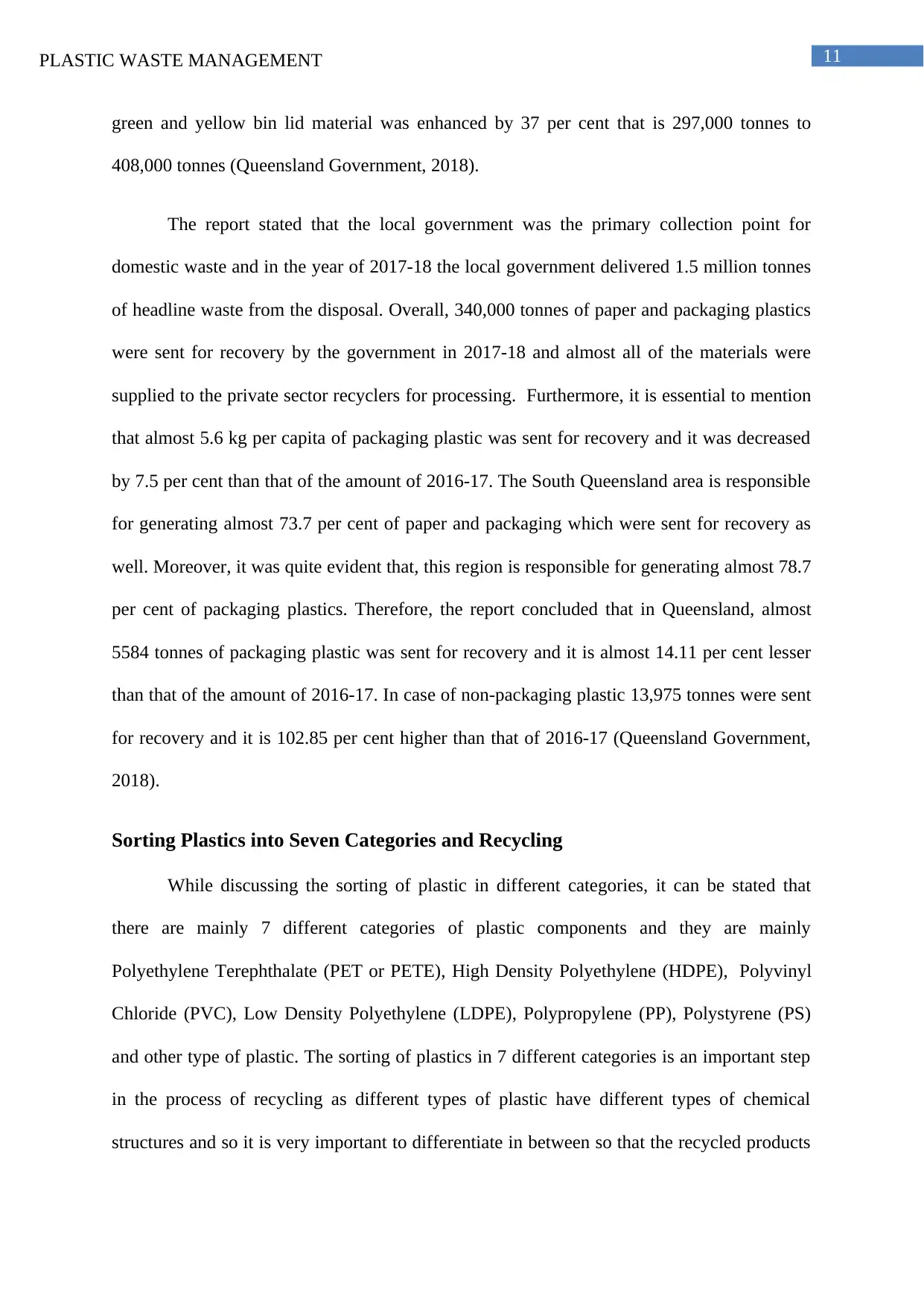
11PLASTIC WASTE MANAGEMENT
green and yellow bin lid material was enhanced by 37 per cent that is 297,000 tonnes to
408,000 tonnes (Queensland Government, 2018).
The report stated that the local government was the primary collection point for
domestic waste and in the year of 2017-18 the local government delivered 1.5 million tonnes
of headline waste from the disposal. Overall, 340,000 tonnes of paper and packaging plastics
were sent for recovery by the government in 2017-18 and almost all of the materials were
supplied to the private sector recyclers for processing. Furthermore, it is essential to mention
that almost 5.6 kg per capita of packaging plastic was sent for recovery and it was decreased
by 7.5 per cent than that of the amount of 2016-17. The South Queensland area is responsible
for generating almost 73.7 per cent of paper and packaging which were sent for recovery as
well. Moreover, it was quite evident that, this region is responsible for generating almost 78.7
per cent of packaging plastics. Therefore, the report concluded that in Queensland, almost
5584 tonnes of packaging plastic was sent for recovery and it is almost 14.11 per cent lesser
than that of the amount of 2016-17. In case of non-packaging plastic 13,975 tonnes were sent
for recovery and it is 102.85 per cent higher than that of 2016-17 (Queensland Government,
2018).
Sorting Plastics into Seven Categories and Recycling
While discussing the sorting of plastic in different categories, it can be stated that
there are mainly 7 different categories of plastic components and they are mainly
Polyethylene Terephthalate (PET or PETE), High Density Polyethylene (HDPE), Polyvinyl
Chloride (PVC), Low Density Polyethylene (LDPE), Polypropylene (PP), Polystyrene (PS)
and other type of plastic. The sorting of plastics in 7 different categories is an important step
in the process of recycling as different types of plastic have different types of chemical
structures and so it is very important to differentiate in between so that the recycled products
green and yellow bin lid material was enhanced by 37 per cent that is 297,000 tonnes to
408,000 tonnes (Queensland Government, 2018).
The report stated that the local government was the primary collection point for
domestic waste and in the year of 2017-18 the local government delivered 1.5 million tonnes
of headline waste from the disposal. Overall, 340,000 tonnes of paper and packaging plastics
were sent for recovery by the government in 2017-18 and almost all of the materials were
supplied to the private sector recyclers for processing. Furthermore, it is essential to mention
that almost 5.6 kg per capita of packaging plastic was sent for recovery and it was decreased
by 7.5 per cent than that of the amount of 2016-17. The South Queensland area is responsible
for generating almost 73.7 per cent of paper and packaging which were sent for recovery as
well. Moreover, it was quite evident that, this region is responsible for generating almost 78.7
per cent of packaging plastics. Therefore, the report concluded that in Queensland, almost
5584 tonnes of packaging plastic was sent for recovery and it is almost 14.11 per cent lesser
than that of the amount of 2016-17. In case of non-packaging plastic 13,975 tonnes were sent
for recovery and it is 102.85 per cent higher than that of 2016-17 (Queensland Government,
2018).
Sorting Plastics into Seven Categories and Recycling
While discussing the sorting of plastic in different categories, it can be stated that
there are mainly 7 different categories of plastic components and they are mainly
Polyethylene Terephthalate (PET or PETE), High Density Polyethylene (HDPE), Polyvinyl
Chloride (PVC), Low Density Polyethylene (LDPE), Polypropylene (PP), Polystyrene (PS)
and other type of plastic. The sorting of plastics in 7 different categories is an important step
in the process of recycling as different types of plastic have different types of chemical
structures and so it is very important to differentiate in between so that the recycled products
⊘ This is a preview!⊘
Do you want full access?
Subscribe today to unlock all pages.

Trusted by 1+ million students worldwide
1 out of 32
Related Documents
Your All-in-One AI-Powered Toolkit for Academic Success.
+13062052269
info@desklib.com
Available 24*7 on WhatsApp / Email
![[object Object]](/_next/static/media/star-bottom.7253800d.svg)
Unlock your academic potential
Copyright © 2020–2025 A2Z Services. All Rights Reserved. Developed and managed by ZUCOL.




